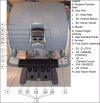Robotic assisted minimally invasive surgery
- PMID: 19547687
- PMCID: PMC2699074
- DOI: 10.4103/0972-9941.51313
Robotic assisted minimally invasive surgery
Abstract
The term "robot" was coined by the Czech playright Karel Capek in 1921 in his play Rossom's Universal Robots. The word "robot" is from the check word robota which means forced labor. The era of robots in surgery commenced in 1994 when the first AESOP (voice controlled camera holder) prototype robot was used clinically in 1993 and then marketed as the first surgical robot ever in 1994 by the US FDA. Since then many robot prototypes like the Endoassist (Armstrong Healthcare Ltd., High Wycombe, Buck, UK), FIPS endoarm (Karlsruhe Research Center, Karlsruhe, Germany) have been developed to add to the functions of the robot and try and increase its utility. Integrated Surgical Systems (now Intuitive Surgery, Inc.) redesigned the SRI Green Telepresence Surgery system and created the daVinci Surgical System((R)) classified as a master-slave surgical system. It uses true 3-D visualization and EndoWrist((R)). It was approved by FDA in July 2000 for general laparoscopic surgery, in November 2002 for mitral valve repair surgery. The da Vinci robot is currently being used in various fields such as urology, general surgery, gynecology, cardio-thoracic, pediatric and ENT surgery. It provides several advantages to conventional laparoscopy such as 3D vision, motion scaling, intuitive movements, visual immersion and tremor filtration. The advent of robotics has increased the use of minimally invasive surgery among laparoscopically naïve surgeons and expanded the repertoire of experienced surgeons to include more advanced and complex reconstructions.
Keywords: Robotic surgery; da Vinci surgery.
Conflict of interest statement
Figures
References
-
- Sackier Jm, Wang Y. Robotically assisted laparoscopic surgery. From concept to development. Surg Endosc. 1994;8:63–6. - PubMed
-
- Dion YM, Gaillard F. Visual integration of data and basic motor skills under laparoscopy influence of 2-D and 3-D video-camera-systems. Surg Endosc. 1997;11:995–1000. - PubMed
-
- Ballantyne GH. The pitfalls of laparoscopic surgery: challenges for robotic and telerobotic surgery. Surg Laparosc Endosc Percutan Tech. 2002;12:1–5. - PubMed
-
- Schurr MO, Breitwieser H, Melzer A, Kunert W, Schmitt M, Voges U, et al. Experimental telemanipulation in endoscopic surgery. Surg Laparosc Endosc. 1996;6:167–75. - PubMed
-
- Ahmed S, Hanna GB, Cuschieri A. Optimal angle between instrument shaft and handle for laparoscopic bowel suturing. Arch Surg. 2004;139:89–92. - PubMed
LinkOut - more resources
Full Text Sources
Other Literature Sources
Research Materials
Miscellaneous








